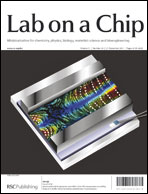DC-biased AC-electrokinetics: a conductivity gradient driven fluid flow†
Abstract
This paper studies the principles of fluid flow manipulation based on DC-biased AC-electrokinetics. This method makes use of planar parallel electrodes in a microfluidic channel in contact with an electrolyte solution, with a DC biased AC electrical signal applied to the electrode pair. Due to the application of DC bias, incipient Faradaic electrolytic reactions take place resulting in an increase of the ionic content of the bulk solution. The ionic content was found to be dissimilar at the cathodic and anodic sides of the channel and a conductivity difference of approximately 10% was measured for 2 VDC. Fluid flow is generated by the action of the DC biased AC electric signal acting on the transverse conductivity gradient generated across the microchannel. The induced flow in the form of vortex was characterized experimentally and the results substantiated theoretically. The velocity of the induced flow vortex under the employed experimental conditions was ∼600 to 700 μm s−1 which is faster than those obtained in conventional AC-electroosmosis and AC-electrothermal types of flows.


 Please wait while we load your content...
Please wait while we load your content...